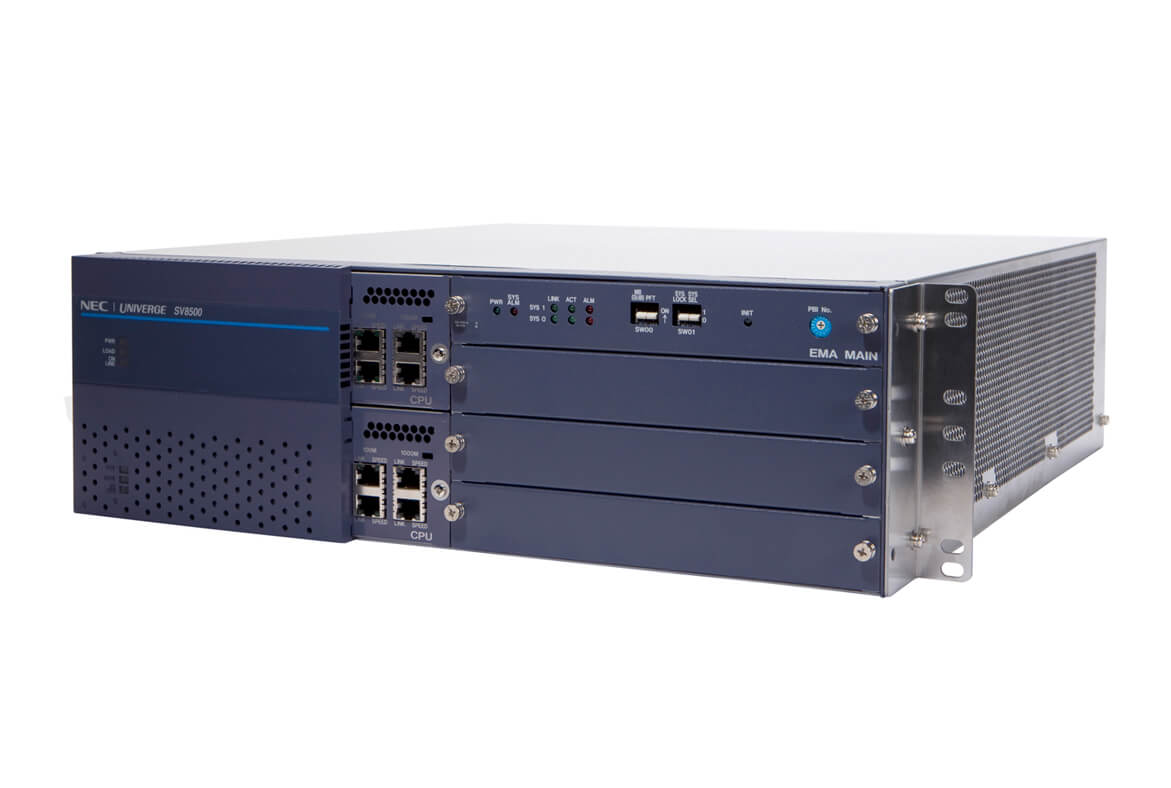Capability
PUBLIC NETWORK INTEROPERABILITY
Interface gateways to Basic Rate, ISDN, SIP Trunks,Primary Rate, and COT PSTN services are provided by the server. It provides for flexible managed least cost routing (LCR) of incoming and outgoing calls. Support for calling line identification (CLI) on both ISDNand PSTN trunks are available with advice of charge (AOC) also available via ISDN.
Direct connection into a mobile carrier through E1 link,ISDN PRA, SIP Trunks, PSTN or QSIG links are supported.
ANALOGUE CONNECTIVITY
Many options for analogue connectivity are available.
For a concentrated deployment of analogue stations at the host site, up to 16 high density chassis (PIR’s) can be provided. This allows up to 384 ports for a 8RU rack mountconfiguration with the 8RU offering full common component redundancy. Install the appropriate 16 station or 24 station packages into the PIR as required.
Theflexible use of a variety of media converters can be implemented throughout a single solution.Ethernet connected IP Media Converters are also available as either 4 ports or 8 ports.
SIP CAPABILITY
From a terminal perspective, the machine supports both standards based RFC SIP andalso NEC Extended SIP. For a SIP terminal to operate on the machine whether it is an UNIVERGE desktop IP Extensions and Softphone, each terminal requires a dedicated license.
A range ofSIP trunk Gateways are also developed. However SIPconnectivity betweencustomer equipment and the Carriers may require additional development depending on theSIP interoperability and functionality required by the customer and carrier network.
TDM CAPABILITY
When deploying a PIR for traditional trunks or stations, there is usually the requirement to provide for voice communication paths between the traditional stations/services and the Pure IP stations/services. To allow this connectivity the server can support the installation into the PIR of a device called an IP-PAD.
The IP-PAD when installed in the PIR allows for the conversion of TDM to IP and vice versa. Depending on your IP deployment requirements, there are different versions of IP-PAD available which can allow for varying options including support for such features as encryption and compression.
Each IP-PAD package is capable of handling up to 32 simultaneous calls.
TRAFFIC CAPABILITY
The SV8500 can provide a capability to handle approximately 1,000,000 Busy Hour CallAttempt (BHCA) in the FCCS configuration.
LICENSING
GENERAL
The Main server is what a basic system hardware configure would consist of. Adding IP Devices, high density Gateways, IP Gateways and a range of terminals are options for added external connectivity.
Load into the server the required licenses as to be able to allow for system expansion and to control all of the options of devices and terminals required for normal operation.
LICENSING DESCRIPTIONS
The server system can be expanded simply by adding the necessary licenses and devices as required. It can start from just a single port with growth available up to the maximum configuration currently supported for a single system of 6,144 high density (PIR) gateway ports.
The solution requires System Capacity Licenses as well as specific licenses to allow the connection of the relevant terminals, applications and devices.
These License details are as follows
(A) System license:
It defines the version and the role. 1 License for 1 CPU is required. System License is divided into two groups;
Main-System: for each market and software version
Sub-System: for additional CPU such as, Remote Site CPU of PIM/PIR over IP and SR-MGC
Each SystemLicense has version information.
(B) System Capacity license:
It defines the size (number of available ports including TDM ports and IP ports) of the system. This license is required per PIR (both Physical PIR and Virtual PIR).
(C) System Option License:
This license is required to provide the additional optional applications on a per application basis such as ACD and OAI. This license is required per Node.
(D) Client License:
It defines the number of client terminal registered. This license is required per IP device.
The Devices includeSP30 Softphone, SIP terminal, UNIVERGE desktop IP extension,WLAN terminal, etc.
(E) Client Option License:
These are two-in-one licenses that combine Client License and OptionLicense.
This license is used as an Option License at FCCS Local-Node. Each device/channel requires this license.
The IP terminals and remote devices will only become accessible after the activation of their specific licenses which are controlled and supported directly from the server. The number of IP device licenses allowed is determined by the available system capacity.
Once a station or device is programmed into the server, all communications with that station or device is classed as an operational heart beat only, which is via the server Ethernet port. The IP device voice paths or station are however always peer-to-peer.
For more information on how https://www.aboveinfranet.com can help you NEC SV8500 Admin Guide: Capabilities and Licensing, please contact us at 0917 715 4189, or visit us here:
Above Infranet Solutions Inc
3F 101 M.L Quezon St. Villa Aurora, Kasambagan Cebu City Cebu / Region 7 6000
 Above Infranet Solutions Inc. is a certified partner of NEC Philippines. Above Infranet can supply, design, install and service a wide range of NEC products. The company is an expert in PABX installation and integration. In addition to Infranet’s unified communications solutions, tools, collaboration, conferencing, and messaging have all become more direct and flexible. Whether requirements are software- or hardware-based, Above Infranet’s Solutions enterprise communications platform provides a comprehensive suite of unified communications and collaboration solutions that deliver an enhanced user experience.
Above Infranet Solutions Inc. is a certified partner of NEC Philippines. Above Infranet can supply, design, install and service a wide range of NEC products. The company is an expert in PABX installation and integration. In addition to Infranet’s unified communications solutions, tools, collaboration, conferencing, and messaging have all become more direct and flexible. Whether requirements are software- or hardware-based, Above Infranet’s Solutions enterprise communications platform provides a comprehensive suite of unified communications and collaboration solutions that deliver an enhanced user experience.
